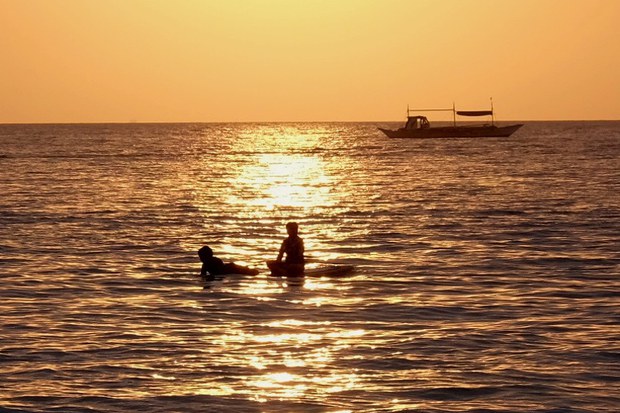Philippines Reopens Boracay Island to Domestic Tourists
2020.10.01
Manila and Cagayan de Oro, Philippines
 Tourists relax as the sun sets on the central Philippine island of Boracay, March 28, 2018.
Tourists relax as the sun sets on the central Philippine island of Boracay, March 28, 2018.
The Philippines’ top tourist draw, the island of Boracay in the central region, reopened Thursday amid COVID-19 fears as the country seeks to balance reviving the economy and protecting the public.
The reopening after almost four months of the island that is famed for its beaches signals the “safe and gradual revival” of a tourism industry stalled by the pandemic, Tourism Secretary Bernadette Romulo-Puyat said.
“What could be a better way to herald the revival of Philippine tourism than the reopening of the world-renowned Boracay Island?” she said, adding the move to allow domestic tourists was a “crucial first step” in reviving the industry.
Puyat noted that while there had been no cases of the novel coronavirus disease detected on the island, health and safety protocols remained in effect.
“We advise all tourists to be on strict quarantine immediately after the PCR test and until the time of travel to the island. This is to help ensure that they will remain free of COVID-19 before they visit Boracay,” she said, referring to the rapid polymerase chain reaction test used to detect infections.
Only tourists coming from regions in the country where quarantine protocols have been relaxed will be allowed to visit the island, she said. In addition, only those without underlying medical conditions and who have tested negative for the virus at least 48 hours before traveling would be accommodated.
Frolibar Bautista, the acting mayor of Boracay island’s Malay municipality, said 26 tourists arrived on the first day, while 95 others were expected but had not completed the health requirements, according to the state-run Philippine News Agency.
Those who made it to Boracay found many shops padlocked at a strip mall once flooded with tourists. A sign stuck on a restaurant’s glass door read “We are temporarily closed due to COVID.”
The few hotels and restaurants that were open advertised social distancing rules, along with and exclusive drinks and food promotions, but had few takers.
Officials said potential tourists must book their stays through accredited establishments, adding each visitor would be given a personal quick response code for monitoring. The code could then be used to track contacts should a visitor test positive for the coronavirus.
“We urge our visitors to be responsible tourists. Follow the guidelines, respect the rules,” Puyat told reporters. “We can never be too complacent, even on vacation, we must adhere to the minimum health protocols. Let’s wear our masks when possible.
“Boracay Island will further open its doors to more local tourist and signal the continued resurgence of domestic tourism nationwide,” she said.
COVID-19
With the Philippines in various stages of lockdown because of COVID-19 and much of the business sector closed, the economy has plunged. Tourism has taken a beating, Puyat said, because airlines and general travel had been barred across the archipelago.
As of Thursday, the health department said the nationwide death toll from the outbreak had reached 5,562, with 59 new deaths reported within the previous 24 hours. In addition, 2,415 infections were logged, bringing the total number of infections to 314,079 – the highest number of confirmed cases in East Asia.
Globally, more than 34 million infections and more than 1 million deaths have been recorded, according to disease experts at U.S.-based Johns Hopkins University.
Meanwhile, President Rodrigo Duterte’s spokesman, Harry Roque, said the reopening of the world-class white-sand beach did not mean the country was in the clear in dealing with COVID-19.
“It means we need to balance the reality that workers in the tourism sector must now resume work,” Roque told a virtual press briefing. “It means that it is possible for us to work if we just take care of our health.”
The beach closing because of the pandemic came two years after the president took similar action based on environmental concerns.
In April 2018, Duterte ordered the island closed for six months of rehabilitation after he described its beaches as “cesspools” and dangers to human health.
At the time Duterte took action, the island had been touted as a regional tourism hotspot to rival Phuket in Thailand and Bali in Indonesia.
Jeoffrey Maitem in Cotabato City, Philippines, contributed to this report.







